Bigfoot’s Killer-N 1102 Wireless Networking vs. the World
by Jarred Walton on August 10, 2011 10:38 AM ESTNetgear 2.4GHz Ideal Performance
Starting with our 2x2:2 2.4GHz Netgear WNR3500L router, testing as expected was particularly variable on the 2.4GHz spectrum. For this test, the router was set up in an upstairs room of my house with no Internet connectivity. The laptops were tested individually (except for the latency test, where a second laptop was also powered on—we used the Bigfoot 1102 equipped laptop, though informal testing suggests the choice of second laptop was irrelevant), at a distance of around five feet from the router.
I adjusted the position and orientation of the laptops during testing in order to achieve what appears to be a best-case result. The connection speeds achieved are as follows: Atheros, 300Mbps; Bigfoot, 300Mbps; Intel 1030, 144Mbps; Intel 6230, 144Mbps; Intel 6300, 300Mbps; Realtek, 144Mbps. You’ll notice that several of the cards were not able to connect at their maximum theoretical speed, specifically the Intel 6230 had issues here on both laptops with that controller, and the Realtek and Intel 1030 connect at 144Mbps instead of 150Mbps. The 6300 does obtain a 300Mbps connection, which is the maximum supported by the Netgear router, and the Bigfoot and Atheros cards also link at 300Mbps. Part of the issue here is the use of 40MHz channels, which are often difficult to maintain in the real world. When the wireless driver (and/or router) detect enough interference to switch to 20MHz channels, you lose a lot of potential bandwidth. Despite numerous reboots and other tweaking, we never could get some of the devices to maintain a 300Mbps connection. With that out of the way, here are the results.
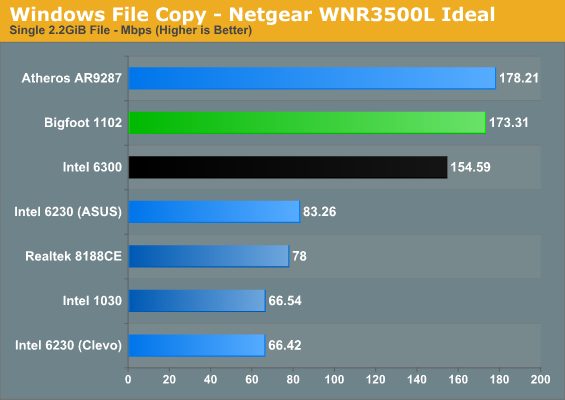
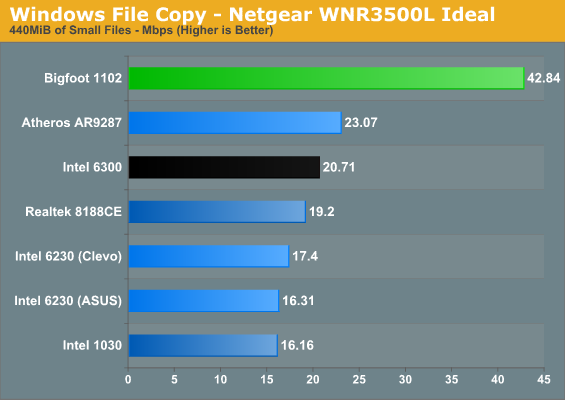
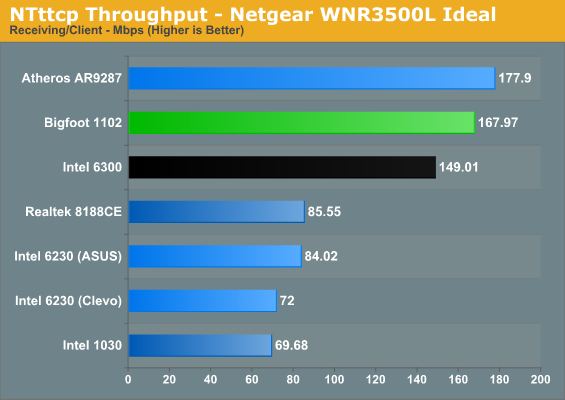
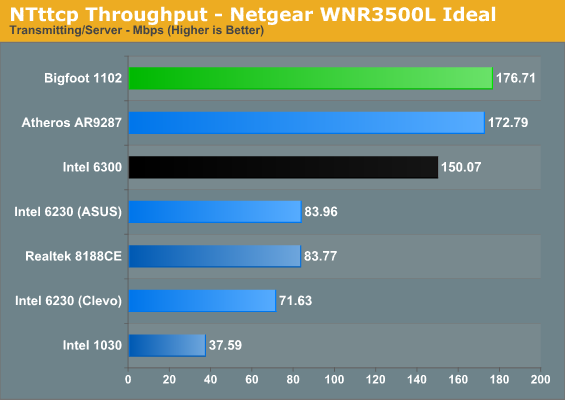

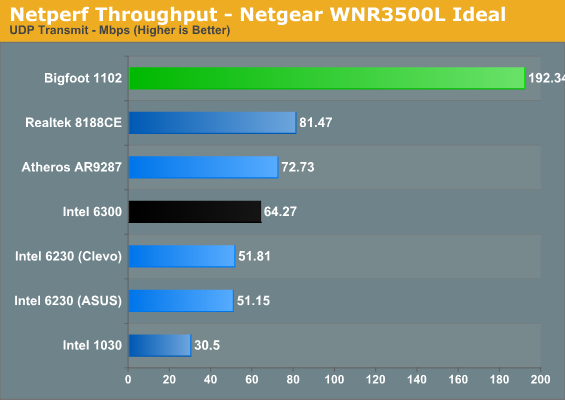
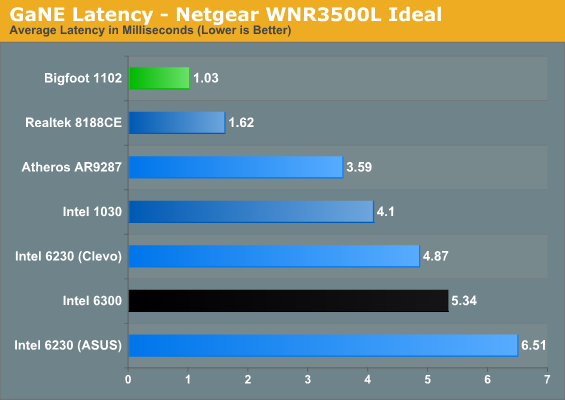
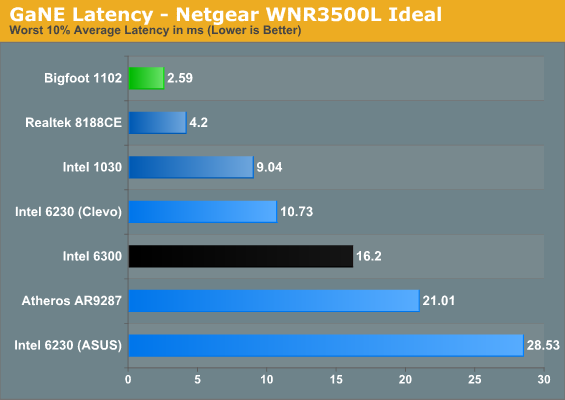
Straight out of the gate, we see a separation develop among the various contenders. At the top of nearly every chart sits the Bigfoot Killer 1102; if it doesn’t outright win, it at least places so close as to be nearly a tie. Keep in mind again that wireless performance is prone to variance, so anything within 5% is close enough that you don’t need to worry much. As noted above, the 6230 would only link up at 144Mbps, which definitely hurts raw throughput; even so, the ASUS K53E appears to work better overall than the Clevo W150HM unit does, showing that not all laptop antennae are equal.
There are two specific tests where the Bigfoot 1102 walks away with the performance crown. The first test is latency, with the 1102 coming very close to wired Ethernet levels of latency (we’ll show those later). The next closest contender for latency is the Realtek solution, and you likely wouldn’t notice the difference. The catch is that there are other areas where the 1102 beats the Realtek quite handily, but we’re getting ahead of ourselves. Outside of the Realtek 8188CE, the Bigfoot 1102’s worst performance is better than the best results from all of the other solutions.
During GaNE testing, virtually every other wireless solution shows occasional spikes of anywhere from 20 to 100+ ms, usually lasting for 5-10 seconds. The Bigfoot 1102 actually showed the same issue, but when we used the Killer Network Manager and set the priority of GaNE to 1 (highest), latency dropped to what we’re reporting above. What’s causing these spikes? It might be Windows searching for other wireless networks; we’re not sure. However, we do have an interesting real-world test that corroborates the GaNE latency results.
If you look at the NTttcp maximum throughput tests, several of the 300Mbps devices are close together. The Atheros AR8132, Bigfoot 1102, and Intel 6300 are all about twice as fast as the other wireless devices. Look at the single large file copy throughput and those same three controllers rise to the top. What’s interesting is what happens when we start copying a lot of smaller files. Suddenly it’s not a question of throughput but is instead how quickly the copy process can transfer each file. Watching the real-time throughput in the networking tab of Windows Task Manager (add the “Bytes Sent/Received per Interval” columns to see this), the lowest throughput on the 1102 is at least double and often triple what the other controllers manage. When you’re copying files and directories, Windows opens a network stream, starts receiving data, and then closes the stream for each file (there might be some other steps, but that description will suffice). If each of those steps ends up taking a few extra milliseconds, multiply that by 9000 and suddenly the process ends up going a lot slower when you have poor latency. In fact, given we’re only transferring 440MiB of data, it appears that the latency/handshaking process takes up around 60 seconds on the Bigfoot 1102 and over 140 seconds on the next closest competitor. Ultimately, GaNE does appear to correlate well with real-world testing.
So do we have a winner in the Bigfoot 1102? If you happen to have a 2x2:2 2.4GHz router (which is probably the most common 802.11n router type) in the same room, the answer is a definite yes. A couple other solutions can come close in terms of pure bandwidth, but the combination of low latency, consistency of connection, and stability offered by the Killer 1102 can’t be beat. Anyone running one of the controllers that only support a single spatial stream (e.g. the Intel 1030 and Realtek 8188CE) will obviously not come close to the same level of performance as the Bigfoot 1102. If you’re after better wireless performance, getting a Killer Wireless-N in your laptop appears to be a good step…but what happens when we move into a different room and obstruct the signal?










52 Comments
View All Comments
Aikouka - Wednesday, August 10, 2011 - link
Jarred, if you asked me about a year ago... I never thought I'd recommend a Netgear product. My past encounters with their networking devices has been less than stellar. Even with that, I decided to take the plunge, and I purchased a WNDR3700 a few months back. It has treated me rather well so far and that's on stock firmware. It is DD-WRT compatible; so if you prefer their firmware, you're good to flash.Compared to the Airport Extreme, it is a bit weaker on the wireless front as it only supports MIMO 2x2, but its newer sibling, the WNDR4000, supports MIMO 3x3.
The one feature I'd definitely argue for though is simultaneous dual-band. I don't think most people have homes with only 5Ghz devices. So with just a dual-band router, you'd be limited to 2.4Ghz anyway.
xand42 - Wednesday, August 10, 2011 - link
Any idea why the (default parameter) netperf tcp transmit results are so horrible across the board? I just ran netperf on my Advanced-N 6200 notebook and got 190Mbit/s to my Cisco E3000 router, basically the same value as with iperf and netcat and every other benchmark.Rick83 - Wednesday, August 10, 2011 - link
It would be fairly interesting to see the difference between the Killer NIC, server NICs, laptop NICs and desktop NIC's from different vendors (and in different implementations).As I run only a SSD in my desktop, and have my user profile residing on a NAS (Intel i5 powered NAS, though, not limited by the available cycles and RAM) on a RAID 5, with reasonable linear throughput, network performance is quite important for me, as it accelerates such tasks as generating thumbnails of files, listing large directories, local decompression (that's probably the worst offender, and with large archives I do this on the NAS directly) and many tasks that access my user profile that may be latency or throughput limited.
For this reason I recently specifically got a mainboard with Intel network adapter, hoping for enhanced performance, but only realizing, that I'd have to hack the .inf to get driver support under my OS.
On the NAS, I am currently using the RTL 8111D chips, one connected to the switch and the other to the modem. If using a decent chip increases my samba/nfs performance, I'd put down the 50 euros for the intel pro chip in a blink.
Also you could test supported cable length, jumbo frame support, documentation (with some cards the maximum MTU is not properly documented, and it takes ages of non-fragmented pinging to discover the correct MTU) and performance of teaming and fail-over mechanisms.
Also, 5Ghz was something that I tried in my parent's home, but we couldn't even connect a machine that was one ceiling and wall away, at less than 10 meters distance. Might have been just a spectacularly bad router (Linksys 320N) or maybe 5GHz is really just for line-of-sight applications.
pityme - Wednesday, August 10, 2011 - link
Jarred,I think it would be nice to run tests of multiple wireless network interference like the kind observed in apartment/townhouse/condo situations. This is a big problem that no one seems to ever test/talk about.
ckryan - Wednesday, August 10, 2011 - link
True that. I live in a condo building in uptown Charlotte, NC and every unit has a wireless router of one kind or another. To make matters worse, the elevators seem to interfere somehow -- along with every wireless phone and microwave, the acres of glass and the steel structure. To top it off, there's an office building right next door which has many wireless systems on its own.ckryan - Wednesday, August 10, 2011 - link
Sometimes it seems like someone has cast some manner of evil voodoo on WiFi as a whole.I bought a Killer 2100 NIC because I thought it was a good idea -- and it was on sale. It is better than Intel's on-board Ethernet (and better still than Realtek) if only just barely. In reality, I just liked the idea of dedicated hardware for my networking needs. It really did make a difference, and really is some good stuff, but probably not worth the substantial premium over garden variety PCIe NICs (for most people). I'm glad I bought it... but only because it was on sale.
The Killer product line is in the position of having a product family which does perform mostly as advertised, but becomes a tough sell when you already have onboard ethernet or wifi. It has to be difficult to sell a consumer NIC that costs as much as a 80GB SSD or mid range video card. For $65 or $70 it's great. At $140, not so much. As such, I'm glad to see them trying to put their hardware inside other hardware, like networking cordon bleu. Shoving their "NPU" onto the PCBs of video and sound cards, motherboards, and laptops is a good idea and if nothing else add a little variety to the mix. It would easily be worth an extra $25 -$35 premium for a motherboard in any price range to get their NIC over the bog standard Realtek. It can't possibly cost more than the NF200 or Hydra chips on mid and high end mainboards and is surely worth an extra $20 on top of a laptop as well. Whether they can sell this particular device sans lappy at a reasonable price or even at all remains to be seen.
honvl - Wednesday, August 10, 2011 - link
I'm on a wireless card and want to test my latency. Where can I find this GaNE tool?Flunk - Wednesday, August 10, 2011 - link
This result really surprised me, I was expecting results like their wired products (no difference). My guess is that the biggest factor is the support for more channels but the performance really does seem markably better. I'm gearing up to by a new Alienware laptop near the end of the year and I may very well check the box for a Killer-N upgrade.StormyParis - Wednesday, August 10, 2011 - link
Isn't there a wide gap between what tech sites review, and what users use ? I know it's part of the purview of a tech site to go for the 0.001%-of-users, bleeding-edge stuff, but... has anyone ever seen a review of mainstream Wifi adapters/laptop anywhere ? As one of the 99.999%, I'd be interested !JarredWalton - Wednesday, August 10, 2011 - link
Bigfoot offered, so I thought, "Hey, this could be fun." Well, it wasn't. WiFi testing is a real pain in the butt I've decided. Still, it would be good to look at some other products. We might come back to the subject in the near future; I'm going to see about soliciting a bunch of different WiFi adapters and see what turns up. Obviously, I have at least the 6230 and 6300 from Intel. I want to add the Killer 1103, some Broadcom stuff, etc. Really, I'd want to focus on just dual-band cards, though -- anything that can't do 5GHz becomes less interesting after playing with the Linksys E4200.